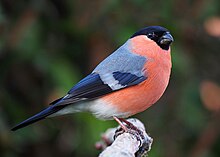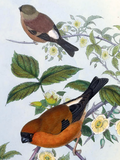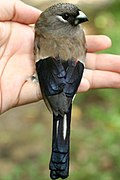
The true finches are small to medium-sized passerine birds in the family Fringillidae. Finches generally have stout conical bills adapted for eating seeds and nuts and often have colourful plumage. They occupy a great range of habitats where they are usually resident and do not migrate. They have a worldwide native distribution except for Australia and the polar regions. The family Fringillidae contains more than two hundred species divided into fifty genera. It includes the canaries, siskins, redpolls, serins, grosbeaks and euphonias, as well as the morphologically divergent Hawaiian honeycreepers.
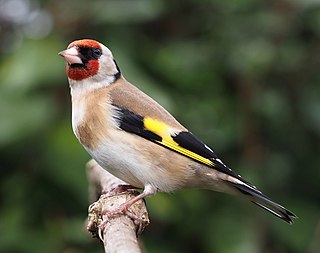
The European goldfinch or simply the goldfinch is a small passerine bird in the finch family that is native to Europe, North Africa and western and central Asia. It has been introduced to other areas, including Australia, New Zealand and Uruguay.

The genus Carduelis is a group of birds in the finch family Fringillidae.

The twite is a small brown passerine bird in the finch family Fringillidae.

The Eurasian bullfinch, common bullfinch or bullfinch is a small passerine bird in the finch family, Fringillidae. In Anglophone Europe it is known simply as the bullfinch, as it is the original bird to bear the name bullfinch.

The hawfinch is a passerine bird in the finch family Fringillidae. It is the only species placed in the genus Coccothraustes. Its closest living relatives are the Chinese grosbeak and Japanese grosbeak of East Asia, and the evening grosbeak and hooded grosbeak of North America.

The pine grosbeak is a large member of the true finch family, Fringillidae. It is the only species in the genus Pinicola. It is found in coniferous woods across Alaska, the western mountains of the United States, Canada, and in subarctic Fennoscandia and across the Palearctic to Siberia. The species is a frugivore, especially in winter, favoring small fruits, such as rowans. With fruit-crop abundance varying from year to year, pine grosbeak is one of many subarctic-resident bird species that exhibit irruptive behavior. In irruption years, individuals can move long distances in search of suitable food supplies, bringing them farther south and/or downslope than is typical of years with large fruit crops.

The grey-capped greenfinch or Oriental greenfinch is a small passerine bird in the finch family Fringillidae that breeds in broadleaf and conifer woodlands of the East Palearctic.

The yellow-faced grassquit is a passerine bird in the tanager family Thraupidae and is the only member of the genus Tiaris. It is native to the Central America, South America, and the Caribbean.

The yellow canary is a small passerine bird in the true finch family. It is a resident breeder in much of the western and central regions of southern Africa and has been introduced to Ascension and St Helena islands.

The brimstone canary or bully canary is a small passerine bird in the finch family. It is a resident breeder in central and southern Africa.
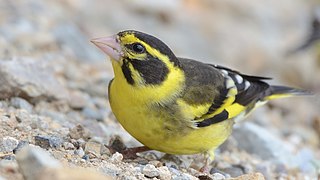
The yellow-breasted greenfinch is a small passerine bird in the family Fringillidae that is native to the northern regions of the Indian subcontinent.
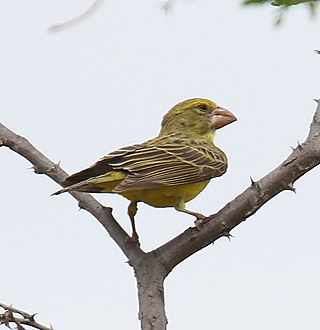
The southern grosbeak-canary, also known as Kenya grosbeak-canary is a species of finch in the family Fringillidae. It is found in Kenya and Tanzania. Its natural habitat is subtropical or tropical dry shrubland.
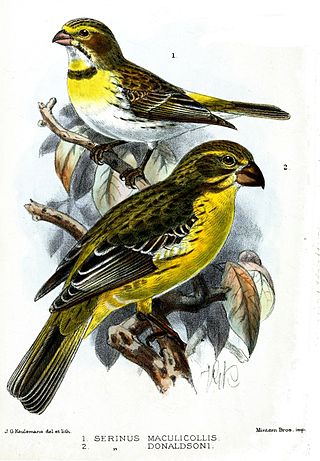
The northern grosbeak-canary or Abyssinian grosbeak canary is a species of passerine bird in the finch family Fringillidae. It is found in Ethiopia, Kenya, and Somalia. Its binomial name commemorates the explorer Arthur Donaldson Smith.

Loxigilla is a genus of passerine birds in the tanager family Thraupidae. The two species are both endemic to the Lesser Antilles.

The Greater Antillean bullfinch is a species of bird in the family Thraupidae.
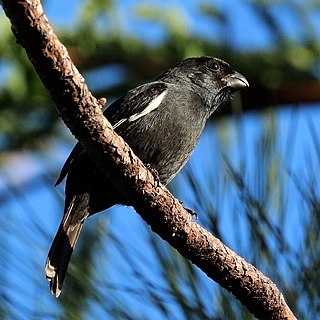
Melopyrrha is a genus of passerine birds in the tanager family Thraupidae. It is made up of four extant species endemic to the Greater Antilles, along with 1 possibly extinct species from the island of Saint Kitts in the Lesser Antilles.

The flame-crested tanager is a species of bird in the family Thraupidae. It is found in Bolivia, Brazil, Colombia, Ecuador, French Guiana, Guyana, Peru, Suriname, and Venezuela. Its natural habitats are subtropical or tropical moist lowland forests and subtropical or tropical dry shrubland. Ten subspecies are currently recognized.

The greater Azores bullfinch was a large, extinct species of bullfinch in the family Fringillidae that was once endemic to the Azores. It is the first known extinct passerine to be described from the islands. It is the largest known member of its genus based on its skull size, and had a very robust beak reminiscent of that of a parrot. However, the remains are otherwise reminiscent of the extant but highly endangered Azores bullfinch.
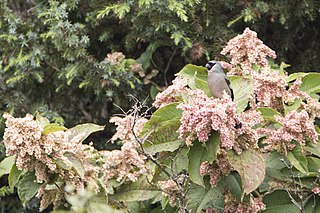
The Taiwan bullfinch is a species of finch in the family Fringillidae. It is endemic to the mountains of Taiwan. It was previously considered a subspecies of the grey-headed bullfinch and most authorities consider it as such, but a 2020 study found it to represent a distinct species that diverged from the mainland Asian P. erythaca during the mid-Pleistocene, and the International Ornithological Congress accepted it as such.
